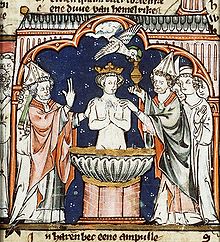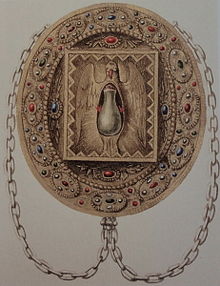Holy ampoule
In the Holy Ampoule (French: Sainte Ampoule ), a one and a half centimeter glass vial, the chrism (anointing oil), which was used to anoint the kings of France , was kept in the cathedral of Reims until the end of the 18th century . With this essential element of the king's elevation, the historical ampoule was first demonstrably used in 1131 at the coronation ceremony of King Louis VII and for the last time in 1774 at the Louis XVI. for use; Remains were used for the coronation of Charles X in 1825.
During the French Revolution , the National Convention decided to destroy the ampoule, a symbol of divine grace . Its public destruction took place on October 7, 1793 in Reims by Philippe Rühl , the representative of Alsace in the National Convention. The contents of the ampoule could be brought to safety the day before.
Legend


When Clovis I was baptized and converted to Christianity in 499 in Reims , the old capital of the Belgica Secunda , the local bishop Remigius of Reims is said to have used the ampoule. When the bishop could no longer get to the place where the prepared holy oils were stored in the crowd in the church of Reims during the coronation, the sky is said to have opened and a dove with the holy ampoule descended to the bishop. With this legend an analogy was made to the baptism of Jesus in the Jordan.
If other European monarchies tried to establish analogies to Old Testament kingship - for example Saul , David or Solomon - only France could boast of having closed its kingship on a divine basis in New Testament analogy. In the sixteenth century, Gallic theologians spoke of the king as a monstrance of the divine will.
That is why the anointing of the king was also one of the main components of the coronation ceremony - called Sacre in French . The ruler was anointed in nine places on his head, hands, shoulders, neck and chest by applying the oil in a cross shape. Before that, the Holy Ampoule was brought into the cathedral in a solemn procession from the Abbey of Saint-Rémi in Reims, where it was kept in the high tomb of St. Remigius. Only the abbot was allowed to open the grave and remove the ampoule, the Bishop of Laon was allowed to carry it into the cathedral. A small portion of the anointing oil contained therein was mixed into the consecrated oil used for the respective anointing. After the ceremony, the remnants of the oil used were returned to the ampoule, which was also supplemented. The queen was simply anointed with holy water.
The “chrism sent from heaven” must have been included in the Reims liturgy by the 8th century at the latest ; the legend of doves was first handed down in writing shortly afterwards by Bishop Hinkmar of Reims . The first royal coronation in Reims took place for Louis the Pious in 816. The use of the anointing oil at the coronation ceremonies is for Charles III. already suspected in the year 893, but is only clearly proven for Ludwig VII. 1131. Thirty kings were anointed in Reims, two in other places, only Louis XVIII. received no anointing. His brother Charles X was the last king to be anointed in Reims in 1825.
In 1793, Philippe Rühl smashed the glass ampoule in a public ceremony on the Place Royale in Reims. The jewelry reliquary, probably from the end of the 12th century, was dismantled and melted down. According to Achille Jubinal , citizens then picked up the splinters from the ampoule and brought them to the bishop. The pastor Jules-Armand Seraine and the city official Philippe Hourelle are said to have taken a large part of the anointing oil the previous evening. The remains were later moved to one of Louis XVIII. commissioned new reliquary and a new ampoule done. This is kept in the archbishop's palace, the Palais du Tau .
heraldry
In heraldry , the sacred ampoule is a heraldic figure that almost always holds a flying dove in its beak. The tinging allows all heraldic colors if there is no conflict with the shield color. The pigeon is shown predominantly with its wings spread towards the base of the shield or flying out of a cloud .
Coming out of the cloud in the coat of arms of the French municipality of Itterswiller , silver ampoule
Coat of arms of the French commune of Lay-Saint-Remy , gold ampoule
Coat of arms of the French commune of Saint-Loup-Terrier , red ampoule
literature
- Ordre pour Oindre et Couronner Le Roi de France, Lyon 1575, éd. mod. by Jean Goy, Reims 1987.
- Jean Goy, La Sainte Ampoule au Sacre des Rois de France , Reims 1994.
Web links
Individual evidence
- ^ Sir Francis Oppenheimer, The Legend of the St. Ampoule
- ↑ Hervé Pinoteau , La symbolique royale française, Ve - XVIIIe siècle, PSR éditions, 2004, p. 113
- ↑ Achille Jubinal: fiche de la Sainte Ampoule [archive] Encyclopédie du XIXe siècle, 1838




